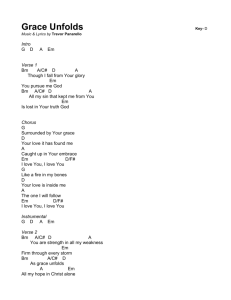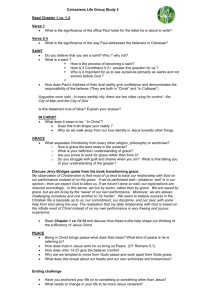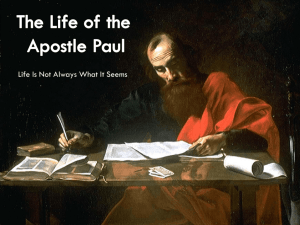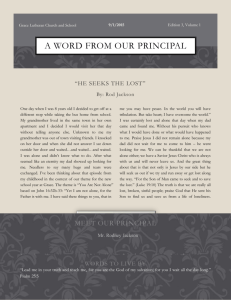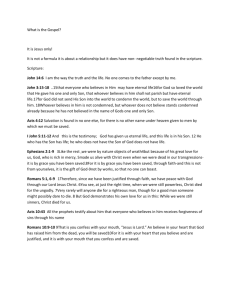Victorian Era: Faith As Seen Through Poetry
advertisement
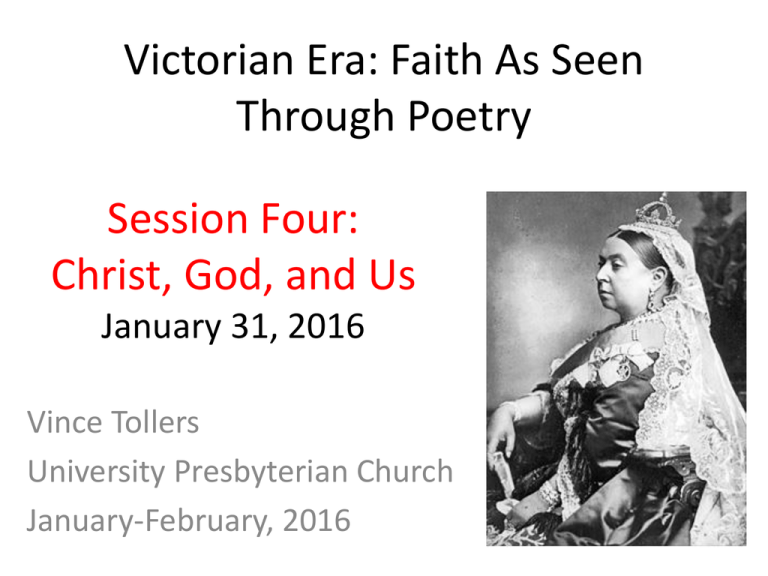
Victorian Era: Faith As Seen Through Poetry Session Four: Christ, God, and Us January 31, 2016 Vince Tollers University Presbyterian Church January-February, 2016 Monarch and Events Victoria: 1937-1901 1830–48: stressful growth--first railways and Reform Parliament 1848–70: prosperity, optimism, and stability 1870–1901: breakdown of internal and external compromises Edward VII: 1901-10 1901-19 modernism meets indolence and indifference George V: 1910-36 WWI (1914-19) Old World ends Series on Church Website • http://upcch.org/adult-education/ – Weekly, following session – Google internet for poems and more information – Bibliography after final session Scheduled Topics • • • • January 3 January 10 January 17 January 31 • February 7 • February 14 Introduction and Change Science and Industrialism Education and religion Christ, God, and us in the universe Sense of self Romance/love (St. Valentine’s Day) Today: Reforms in Religion and Art • Humanizing Jesus – Church of England/Anglican Reform • Protestant/Dissenter Reform – Quakers – Wesley/Methodists/Evangelicalism – Growth of hymn singing that show new views of Jesus • Anglo-Catholic and Catholic Poets 19th C Balance: “Function of Art?” Horace’s “To Teach • Meter-making argument (Emerson) – Philosophical – Art for society’s sake • To teach: enhanced universal lessons – – – – Public/general view Hymns Pragmatic/realistic Worldly To Delight” • Rhythmical creation of beauty (Poe) – Aesthetic – Art for art’s sake • To delight: experiences can’t be reduced to plots and themes – Private, personal view – Idealistic – Magical Humanizing Jesus in 19th C • German Protestant theologian: D R Strauss. Das Leben Jesu (The Life of Jesus) (1835) • Trans. by George Eliot (1846) • Separates Jesus the man from the Christian faith • Christ as historical figure: gospel miracles about Jesus are myths – Rationalism generally supported • Jesus Seminar (Marcus Borg, etc. modern adherents) – “supernaturalists” opposed • Bible is accurate: historically and spiritually Anglican Reforms (1833-41) • Oxford Movement – Newman and 12 others write 90 Tracts for the Times • Purity of early church • Tied to gothic architectural revival • Newman converts to Catholicism – First sees C of E as the middle way – Converts to Catholicism • As Provost of Dublin University, writes Ideas Dissenter/Non-Conformists Reform • Rich tradition of 18th19th C hymns and poetry • Quakers • Evangelicals/ fundamentalists • Methodists John Wesley in St. Paul’s Cathedral Garden Quakers or Religious Society of Friends • After 1689 Toleration Act, grew in northern UK • 19th C, central to social justice and equality – Equal rights for women – Prison reform – Assistance to poor – Abolition of slavery John Wesley (1703–91) Non-Conformist Reformer The 2nd Great Awakening was led by the Wesley brothers and Whitfield in the UK and US The Holy Club met in the Oxford chapel. From there, the Wesley brothers sought reform with the C of E before the schism Evangelical Tenets • • • • • • • The inherent sinfulness of man Religious conversion (missions, etc.) Atonement Activism (social justice) Devotion to the Bible God's providence The belief in an eternal life after death Wesley: Grace Couched in Meter-Making Argument Charles Wesley (1707-88) wrote over 5,500 hymns including And Can It Be That I Should Gain?, O for a Thousand Tongues to Sing, and Hark! the Herald Angels Sing. We have 13 of his hymns in Glory to God. Oh, for a thousand tongues to sing My great Redeemer’s praise, The glories of my God and king, The triumphs of His grace! He breaks the pow’r of canceled sin, He sets the pris’ner free; His blood can make the foulest clean, His blood availed for me. Reformed Hymns Largely Victorian Shift from 18th C rationalism and focus on God the creator to Jesus the man who saves us by grace and calls for living out our faith in gratitude and with the Golden Rule. In 2015, about a third of hymns sung at UPC were composed 1750-1900. Amazing Grace (1789) John Newton Amazing grace! (how sweet the sound) That sav'd a wretch like me! I once was lost, but now am found, Was blind, but now I see. Twas grace that taught my heart to fear, And grace my fears reliev'd; How precious did that grace appear, The hour I first believ'd! Catherine Winkworth (1827-78) O Lord, How Shall I Meet You, how welcome you aright? Your people long to greet you, my hope, my heart’s delight! O kindle, Lord most holy, a lamp within my breast, To do in spirit lowly all that may please you best. …your thirst for my salvation procured my liberty ….you embrace… our lost and fallen race. You come, O lord with gladness, in mercy and good-will…. Anglo-Catholic and Catholic Poets • Influence of John Donne and other 17th C metaphysical poets • Francis Thompson • Christina Rossetti • Gerard Manley Hopkins 19th C Balance: “What is poetry?” Horace’s “To Teach and To Delight” • Meter-making argument (Emerson) – Philosophical – Art for society’s sake • Teaches: enhanced universal lessons – – – – Public/general view Hymns Pragmatic/realistic Worldly • Rhythmical creation of beauty (Poe) – Aesthetic – Art for art’s sake • Delights: experiences that can’t be reduced to plots and themes – Private, personal view – Idealistic – Magical Iconography in A-C and Catholic Poetry • Realists depicted the world concretely – A photographically-accurate tree is a tree • Aesthetics, after the 1850s, showed the visible tree as a symbol of something behind it – See the spiritual, metaphysical world interwined with the physical Aesthetic Characteristics • Vividly shows rather than tells a story in pictures/icons/language – MacLeish A poem should not mean But be. – Widely illustrated • Wide use of the Bible and classical myths • Personal relationship with Christ • Christ offers grace to the unworthy (like evangelicals) John Donne (1572–1631) • Renaissance Anglican metaphysical poet • Victorians rediscovered • T.S. Eliot and others add Hopkins and Dickinson • Complicated and witty • His “Batter My Heart” forerunner to Anglo-Catholic and Catholic poets Batter my heart, three-person'd God, for you As yet but knock, breathe, shine, and seek to mend; That I may rise and stand, o'erthrow me, and bend Your force to break, blow, burn, and make me new. I, like an usurp'd town to another due, Labor to admit you, but oh, to no end; Reason, your viceroy in me, me should defend, But is captiv'd, and proves weak or untrue. Yet dearly I love you, and would be lov'd fain, But am betroth'd unto your enemy; Divorce me, untie or break that knot again, Take me to you, imprison me, for I, Except you enthrall me, never shall be free, Nor ever chaste, except you ravish me. Jean-François Millet, The Gleaners, 1857. Realism Symbolism in the Pre-Raphaelite Brotherhood School I Am the Light of the World (1854) Holman Hunt (1827–1910) Revelation 3:20: "Behold, I stand at the door and knock; Pre-Raphaelite Brotherhood • Started in 1848 • Christina, William and Dante Rossetti, Holman Hunt, John Everett Millais, etc. • Follow nature; reject surface classicism of Reynolds – Use biblical and classical subjects Painting: symbols of bat, torch, white rose, and pomegranate Proserpine, by Dante Gabriel Rossetti Francis Thompson (1859-1907) • Aesthetic Catholic poet The Hound of Heaven (1893) "`Can anyone hide in secret places so that I cannot see him?' declares the Lord. `Do not I fill both heaven and earth?' declares the Lord." (Jer 23:24). • C.S. Lewis had similar experience. (see handout) Christina Rossetti (1830-94) • Anglo-Catholic • Romantic, devotional, and children's poems • Noted poems – “In the Bleak Mid-Winter” (hymn) – “Remember (covered on Feb 14th) – “Up-Hill” – “Good Friday” – “Goblin Market” Rossetti’s “Good Friday” Handout • Illustrates PRB tenets • Like “Amazing Grace” – Lost sinner saved by Christ • Adds richness/density – Rich, multiple meanings of “stone” “Peter,” and “rock” (line 1 and 16), “sheep” (lines 1 and 14) Goblin Market (1962) Christina Rossetti Laurence Housman’s wood engraving, 1892 Goblins described lines 1-15 and 50-59 Laura’s “eat me, drink me, love me” lines 20-29 Gerard Manley Hopkins (1844-89) •Aesthetic, brilliant, bi-polar •Placed after Tennyson, Browning and maybe Arnold •Influenced by these, and Romantics and PRB •As Oxford student, influenced by Newman, he converts to Catholicism, goes on to teach at Dublin Univ •Suppressed poems published by Bridges in 1918. Best known Pied Beauty God’s Grandeur Windhover Hopkins: Bridge to Modern Poets Instress on Inscape • Inscape: imagine a lone tree growing into the world rather than being a part of the world (landscape) • Instress: like Wordsworth’s “spots of time”: to GMH, a religious ahah. – Imagist (John Ciardi): a poem is not what it means but how it means The Windhover • Imagistic • Relationship between the “I” and Christ as seen in nature I caught this morning morning's minion, kingdom of daylight's dauphin, dapple-dawn-drawn Falcon, in his riding Of the rolling level underneath him steady air, and striding High there, how he rung upon the rein of a wimpling wing In his ecstasy! then off, off forth on swing, As a skate's heel sweeps smooth on a bow-bend: the hurl and gliding Rebuffed the big wind. My heart in hiding Stirred for a bird, – the achieve of, the mastery of the thing! Brute beauty and valour and act, oh, air, pride, plume, here Buckle! AND the fire that breaks from thee then, a billion Times told lovelier, more dangerous, O my chevalier! No wonder of it: shéer plód makes plough down sillion Shine, and blue-bleak embers, ah my dear, Fall, gall themselves, and gash gold-vermilion Kestrel: “this morning, morning’s minion” dives at 175 mph https://youtu.be/31Xw75hAwIc Next Week: Nature and Changing Sense of Self • • • • Gerard Manley Hopkins Meredith Yeats Kipling The Victorian Challenge: Change • Sense of Christ, God, and us in the universe – Anglo-Catholic and Catholic Poets • Science and industrialization • Education and Religion • Social justice • England’s place in the world • War
